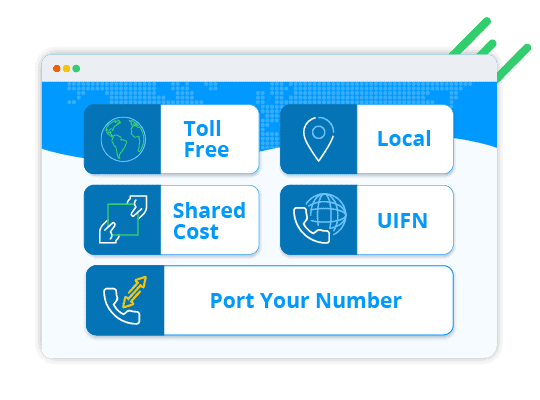Estonia Virtual Phone Numbers
Estonia Virtual Phone Numbers
Estonia virtual numbers allow you to take and make calls from anywhere. Buy an Estonia phone number online and start managing calls in minutes!
Buy Estonia Phone Numbers Online, Risk-Free

Get Reliable Estonia Virtual Numbers for Business Today
Estonia virtual phone numbers, also known as VoIP numbers, are real phone numbers with business features built-in. Manage your numbers from AVOXI's intuitive web-based interface or route our voice services through your existing phone system setup.
Get toll free and local virtual numbers in Estonia with no setup fees or minimum contracts. Try Estonia VoIP services risk-free today!
Common Questions About Estonia Virtual Numbers
When you purchase an Estonian virtual number in the online shopping cart, your new business number is set up and activated within 30 minutes or less. If your business email does not match your listed company, an AVOXI expert may reach out to confirm your account details before unblocking the number.
To use our services with existing virtual numbers in Estonia, simply transfer your VoIP phone numbers to AVOXI. Porting Estonia virtual telephone numbers is a simple process.
Yes, if you are using an AVOXI number designated as TrueLocal. These numbers are guaranteed to work as your outbound caller ID and can be found listed in our online shopping cart.
There are no special documentation requirements to get toll free Estonia virtual phone numbers.
For local Estonia numbers, you may be required to provide End User Details and/or Worldwide Address.
Yes! AVOXI SIP trunking is a perfect alternative to Estonia Calling Plans in Teams. Our built-in, Microsoft-approved SBC solution makes configuration in Teams quick and easy.
In addition to the best Estonia virtual phone number services for business, popular solutions from AVOXI include International VoIP Numbers, Virtual Contact Centers, and Global SIP Trunking.
Executive Summary
Establishing a business presence in Estonia, particularly for international companies, requires a strategic approach to communication, which can be seamlessly achieved through virtual phone numbers. These numbers are integral to market entry strategies, enabling businesses to localize their communication, enhance customer trust, and streamline operations. This guide offers a comprehensive overview of how virtual phone numbers can be leveraged to tap into Estonia’s dynamic business environment, while addressing industry-specific use cases, common concerns, and a step-by-step implementation guide.
Market Overview (Business Landscape & Communication Infrastructure)
Estonia is one of Europe’s most advanced digital economies, known for its robust e-government, efficient digital infrastructure, and strong innovation-driven industries. Estonia ranks highly in terms of business ease, transparency, and technology adoption, with a growing startup ecosystem and established international business ties. The country’s highly connected population and widespread use of digital technologies present an ideal environment for companies to engage with local consumers.
Estonia's communication infrastructure is exceptionally modern, with widespread mobile network coverage and high internet penetration. Virtual phone numbers are an important tool within this ecosystem, providing businesses with an affordable and effective way to establish a local presence without the overhead of traditional physical offices.
Virtual Numbers in Market Entry Strategy
Virtual phone numbers are a cost-effective solution for companies seeking to establish a local presence in Estonia without committing to physical infrastructure. These numbers allow businesses to be reached by local customers via standard dialing codes, while enabling international companies to manage operations remotely. When integrated into a broader market entry strategy, virtual numbers can facilitate customer engagement, enhance brand credibility, and improve customer satisfaction by offering familiar communication channels.
They also offer businesses a flexible solution to scale their operations, enabling quick adjustments to marketing campaigns, customer support processes, or even changes in market strategy. Virtual numbers help businesses position themselves as local entities, boosting customer confidence and engagement in a competitive market.
Industry-Specific Applications
Tech Industry
In Estonia, which is known as a European tech hub, virtual numbers are vital for software companies, IT consultants, and startups looking to reach local clients or partners. A virtual number can serve as a support hotline, project inquiry line, or customer service contact, helping businesses maintain a local presence while keeping overhead costs low. For example, a SaaS company headquartered in the U.S. can use Estonian virtual numbers to handle client queries and offer customer support in the local language, creating a more personal and accessible interaction.
Retail
For retail businesses, both online and physical stores, virtual phone numbers can provide customers with a direct line to sales or customer service teams. Whether it's for order inquiries, returns, or general support, virtual numbers create a localized experience for Estonian customers while providing the company with the flexibility to route calls globally. This is particularly beneficial for businesses that may not have a physical storefront in Estonia but want to establish trust with local customers.
Professional Services
Consulting firms, legal services, and financial advisors often rely on virtual phone numbers to serve clients across borders while maintaining local accessibility. Virtual numbers can be used to route calls to different teams or departments, ensuring that a local representative is always available. For example, a law firm based outside of Estonia can use a local Estonian virtual number to handle consultations and inquiries, making it easier for Estonian clients to engage with the firm without dealing with international dialing issues.
Addressing Common Concerns
Perceived Lack of Physical Presence
One common concern about using virtual numbers is the perception that the business lacks a true "local" presence. However, businesses can counter this by providing exceptional service, localized marketing materials, and a responsive customer support team. Additionally, virtual numbers can be combined with other strategies, such as local addresses or representation through partner networks, to further legitimize the business in the eyes of customers.
Fraud and Trust Issues
Another concern relates to the potential for fraud and the use of virtual numbers in scams. However, by choosing a reputable virtual phone number provider with robust security measures, businesses can mitigate this risk. Providing clear communication about the legitimacy of the business and its operations further builds trust with customers.
Customer Support Complexities
Managing virtual numbers from remote locations may raise concerns about how effectively customer inquiries can be handled. The key is to implement a cloud-based phone system that allows for seamless call routing and integration with CRM systems. This ensures that customer queries are answered promptly, regardless of the location of the business team.
Implementation Guide (Preparation, Launch, Operations)
Preparation
- Research Local Regulations: Understand Estonia’s telecommunication laws, including any specific requirements for businesses operating with virtual phone numbers.
- Select a Reliable Virtual Phone Number Provider: Choose a provider with strong customer support, a variety of number options (e.g., toll-free, mobile), and seamless integration capabilities with your existing systems.
- Determine Usage Goals: Decide how the virtual number will be used (e.g., for sales, customer service, or support) and plan your communication strategy accordingly.
Launch
- Setup: Activate your virtual number, integrating it with your CRM, helpdesk systems, and any other tools you use for customer interaction.
- Test the System: Ensure that calls are routed correctly, voicemails are captured, and the number is functioning properly across all channels.
- Marketing: Announce your Estonian presence through targeted marketing campaigns, using the virtual number as the main contact point.
Operations
- Monitoring and Reporting: Continuously monitor call volumes, customer interactions, and number performance to ensure smooth operations. Implement call tracking to measure ROI.
- Scalability: As your business grows, consider adding more virtual numbers to cover different regions, products, or services.
- Customer Feedback: Regularly collect customer feedback to identify areas for improvement in the communication process.
Best Practices
- Personalization: Use the virtual number for personalized communication, including regional language support or specific time zone availability.
- Multi-channel Integration: Integrate the virtual number with other communication channels like email, chatbots, and social media to create a seamless omnichannel experience.
- Professional Voicemail: Ensure that your voicemail system reflects professionalism with a local touch, offering customers a personalized message and next steps.
Next Steps
- Contact Providers: Reach out to several virtual phone number providers to compare costs, features, and services.
- Train Your Team: Provide training for your team on handling calls from virtual numbers and maintaining excellent customer service standards.
- Evaluate and Scale: Monitor the success of the virtual number in your initial operations and expand as needed.
Conclusion
In conclusion, virtual phone numbers offer a versatile and cost-effective solution for businesses seeking to establish a presence in Estonia. By integrating virtual numbers into a broader market entry strategy, companies can offer localized services, improve customer trust, and scale operations more easily. Whether you are in tech, retail, or professional services, virtual phone numbers help you engage with Estonian customers on their terms—providing flexibility, reliability, and a professional image without the complexities of physical infrastructure.























